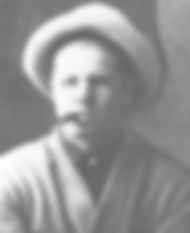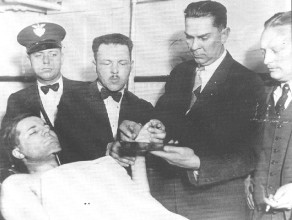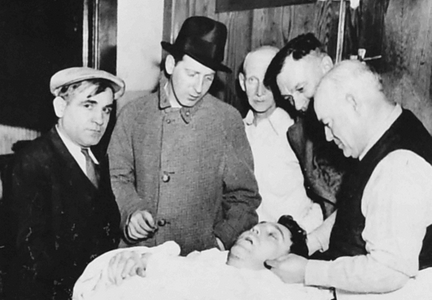Pretty Boy Floyd: The Folk Outlaw of the Great Depression
- Daniel Holland
- Oct 22
- 13 min read

If you lean in close you can almost hear the corn leaves rasping in the Ohio wind. It is late afternoon on 22 October 1934 near East Liverpool and a compact figure in a dark suit is trying to run in broken ground with lawmen closing from two directions. Shots crack across the field. He stumbles. Someone hears him speak through clenched teeth, a line that would be repeated in print for decades. “I am done for. You have hit me twice.” Within minutes Charles Arthur Floyd is dead. Within days he is myth.
That single scene has been told and retold so many times that it can feel like all there ever was. Yet the road to that cornfield began years earlier in a red dirt corner of the American South, passed through oil leases and rail yards and small town banks, and picked up a legend as it went. To his pursuers he was a dangerous robber with blood on his hands. To many ordinary people he was the Robin Hood of the Cookson Hills, a man who refused to bow to bankers and bosses in the worst years anyone could remember. The truth, as usual, sits somewhere in between.
“Some will rob you with a six gun and some with a fountain pen.”Woody Guthrie, Ballad of Pretty Boy Floyd
Guthrie never met Floyd but he understood the times that made him. This is the story behind the song. It is the way a shy farm boy from Georgia became a headline, how he was hunted across three states, and why people still argue over what he did and did not do more than ninety years later.

Early life in Georgia and Oklahoma
Charles Arthur Floyd was born on 3 February 1904 in Adairsville in Bartow County, Georgia, to Walter Lee Floyd and Mamie Helene Echols. When Charles was seven the family joined the stream of Southerners drifting west for a chance at better land, settling near Akins in Sequoyah County, Oklahoma. They farmed, they struggled, and they raised a boy who learned to work hard and to look out for his own.
By eighteen Floyd had his first brush with the law. He was arrested after taking three dollars and fifty cents from a post office. Adjusting for inflation that is roughly sixty dollars today, the price of a week of groceries if you knew how to stretch a dollar in rural Oklahoma. The amount was small but the warning was large. Three years later, on 16 September 1925 in St Louis, he was arrested again for a payroll robbery and sentenced to a term in the Missouri penitentiary. He served about three and a half years before parole. Those months in prison taught him the rhythms and argot of the Midwestern underworld and supplied partners who would shape his next five years.
How Charles became Pretty Boy
After parole he gravitated to Kansas City, a town where machine politics and organised crime coexisted in plain sight. Here he picked up the nickname that stuck to him in every newspaper column thereafter. Accounts differ. One version says an oil field hand named Orville Drake started calling him Pretty Boy because he turned up to manual work in pressed slacks and a white shirt. Another version says a victim in a St Louis holdup described one robber as “a pretty boy with apple cheeks.” Whatever the origin, Floyd despised the name. He preferred to be called Choc, a nod to his love for Choctaw beer, but tabloid nicknames are stubborn things and Pretty Boy he remained.
A working life of crime
By 1929 Floyd was wanted in connection with robberies in several states. He was stopped and questioned more than once that spring, ticketed for vagrancy in Pueblo, Colorado, and sometimes released within a day because witnesses could not make an identification stick. He carried the usual tools of his trade for the time, most famously a Thompson submachine gun that newspapers loved to mention, and he often worked with small crews of experienced stick up men who could case a bank, move fast, and scatter.

He was arrested in Akron, Ohio, on 8 March 1930 under the alias Frank Mitchell in connection with the killing of an officer during an evening robbery. That case never came to trial. Later that spring he was arrested again in Toledo for bank robbery.
On 24 November 1930 he was convicted of robbing a bank in Sylvania, Ohio, and sentenced to a twelve to fifteen year term. He escaped. From that point on the chase hardened. Patrolman R H Castner was killed in Bowling Green, Ohio, in April 1931 by members of Floyd’s crew. The same year the Ash brothers, Kansas City rum runners, were found dead in a torched car. In July 1932 former sheriff Erv Kelley of McIntosh County, Oklahoma, was shot and killed when he tried to arrest Floyd in person. By then Floyd had crossed a line in the minds of lawmen. He was no longer just a quick hand with a bank job. He was a man who could not be brought in without risk and who would rather shoot than surrender.
The Robin Hood of the Cookson Hills
All the while something curious was happening in the towns and farms where he occasionally laid up. Word spread that when he robbed a bank he asked for the mortgage ledger and burned it in front of the clerks. Whether that ever happened as cleanly as the stories claim is doubtful. Bank paperwork was spread across ledgers, filings, and deeds. Destroying one book could not wipe a debt from the world. But the rumour took hold precisely because mortgages had taken hold of people’s lives. If the choice was between bankers who foreclosed and a bandit who might tear up a page with your name on it, the bandit began to look like justice. In the Cookson Hills of eastern Oklahoma people fed him, gave him a bed, watched for unmarked sedans on the road, and called him their Robin Hood. Folklorists sometimes talk about the outlaw hero, a figure who steals from the rich and helps the poor, and who stands as a scold of corrupt authority. Floyd is one of the rare real people to be absorbed into that folktale.
Anecdotes from Oklahoma carry the flavour of that time. One woman remembered a polite stranger asking if he could borrow her car for an errand. He sent it back washed and full of petrol. Another man said a visitor in a good suit quietly paid his overdue store account and left without giving a name. Are these stories precisely true. Perhaps not. But they explain why a thousand people might decide not to see a face when asked by a stranger with a badge.
The Kansas City Massacre that will not settle
At dawn on 17 June 1933 gunfire erupted outside Union Station in Kansas City. Lawmen were moving a federal prisoner named Frank Jelly Nash from the station to a car when at least three gunmen opened fire with rifles and automatic weapons. In seconds Police Chief Otto Reed, Detectives Frank Hermanson and William Grooms, and Special Agent Raymond Caffrey were dead. Nash was killed too, shot through the head by his would be rescuers. The gunmen fled.
The Bureau of Investigation very quickly named Vernon Miller as an organiser of the attack and pointed to Floyd and his partner Adam Richetti as Miller’s accomplices. There was evidence to support the claim, including eyewitness identifications, the presence of Floyd and Richetti in the region, and a fingerprint attributed to Richetti found on a bottle at one of Miller’s hideouts. There was counter evidence too. Some underworld sources insisted Floyd was not there. Ballistics work published decades later argued that friendly fire from a short trained lawman accounted for some of the worst carnage. A rumoured shoulder wound to one gunman did not match the wounds found on Floyd’s body. The Floyd family said Chock denied the massacre every time they asked him. The Kansas City Police Department received a postcard dated 30 June 1933 that read, “Dear Sirs I Charles Floyd want it made known that I did not participate in the massacre of officers at Kansas City. Charles Floyd.” The department believed the card was genuine.
This uncertainty matters because the massacre became a turning point in federal law enforcement. J Edgar Hoover used it to argue for stronger national powers, better weapons, and a broader mandate for his agents. When John Dillinger was killed in July 1934, Hoover named Pretty Boy Floyd Public Enemy Number One and committed his growing force to the hunt.

The last run across New York, Pennsylvania, and Ohio
The final act began with a simple accident. On 18 October 1934 Floyd and Richetti left Buffalo in the company of two women. In heavy fog before dawn their car slid into a telephone pole on an Ohio road. No one was hurt but the radiator was gone. The men hid off the verge and sent the women to find a tow. A farmer named Joe Fryman and his son in law noticed two men in suits lying beside the road and told the Wellsville police. Officers John Fultz, Grover Potts, and William Erwin went to investigate.
What followed was a fast moving exchange that reads like a fever dream when told by different men at different times. Richetti bolted into the woods with two officers behind him. Fultz stepped toward Floyd, who drew a pistol and fired. Fultz took a bullet in the foot. Potts was hit in the shoulder. Floyd vanished into the brush. A World War One sniper turned local officer named Chester Smith joined the search. Richetti was captured. Floyd kept moving. By 22 October the net had tightened around East Liverpool.
That afternoon he ate at a pool hall belonging to a friend named Charles Joy and then hitched a short ride. Agents and officers later said they spotted a car tucked behind a corn crib on a farm south of town. What happened next is the most disputed passage in the most disputed life.
One account comes from the Bureau of Investigation. Special Agent Winfred Hopton remembered that four federal men led by Melvin Purvis and four East Liverpool officers led by Chief Hugh McDermott approached together. Floyd stepped from cover with a .45 in his hand. The agents fired.
Floyd fell and said, “I am done for. You have hit me twice.” He died soon after, still refusing to answer questions about Kansas City. In this version local police arrived only after the shooting had ended.
Another account was offered decades later by Chester Smith in an interview reported by Time. He said he fired first with a .32 Winchester, wounding Floyd in the arm and knocking him down. He said Purvis then ordered an agent to finish Floyd at close range with a machine gun when the wounded robber refused to talk. Federal men who had been there rejected Smith’s story immediately. Hopton wrote a letter to the editor insisting that Smith was wrong and that Agent Herman Hollis, whom Smith had named as the man with the gun, was not even present. Later researchers have also noted that Hollis’s official record makes no mention of East Liverpool that day.
Some details are not in dispute. Floyd had three serious wounds. The watch and fob found on him carried ten small notches. Hoover privately speculated the marks stood for men Floyd had killed and ordered the watch photographed before his personal effects were sent to Floyd’s mother. However you read the testimonies, the moment blew up a man who had been chased for five years into a legend that could be told two ways from the start.
The funeral that stopped eastern Oklahoma
Floyd’s body was embalmed in East Liverpool, then returned to Oklahoma. The viewing in Sallisaw drew a crowd that local people still talk about. Estimates range from twenty thousand to forty thousand, a crush of farm families and oil hands and people who travelled half a day to see whether the stories matched the face in the coffin. Men removed their hats. Women brought children forward in a hush like Sunday. He was buried in Akins under a clean Oklahoma sky.

Two local officers, Robert Pete Pyle and George Curran, belonging to the web of county men who had chased him over the years, were present both at the shooting and at the embalming. Historians still debate exactly which officers stood where and who pulled which trigger. That argument will never entirely close because what people think they know about Pretty Boy Floyd has always depended on who is doing the telling.
What part of the legend holds up
It helps to separate myth from fact without sneering at either.
The mortgage fires. There is no reliable documentary proof that Floyd truly erased debts with a match. He may have torn up papers. He could have demanded a ledger. But bank debts were not so easily extinguished. The story made sense in the ears of the people who most wanted to believe it. That makes it folklore, not evidence.
The Kansas City Massacre. Cipher this however you like and you will still find uncertainty. The Bureau named Floyd and Richetti quickly and pushed the case for years. Others disputed it in the same breath. The best you can say is that there is evidence both ways and that ballistics work published long after suggested that some killing was friendly fire.
The body count. The ten notches are striking but they prove nothing on their own. A hard running bank robber in the early nineteen thirties lived in a world of guns. Patrolmen died in Ohio and Oklahoma. A federal agent named Curtis Burke died in Kansas City. Floyd himself lived by the pistol. This was a time when a man who chose that life tended to die by it too.
The last words. Variants of “I am done for. You have hit me twice” appear in more than one contemporary account and do not flatter anyone. They sound true precisely because they are not theatrical. They sound like a hurt man stating a fact.

Why people still care
The Great Depression scarred the American imagination. Banks closed. Mortgages were called in. Men who had never asked for any favour found themselves standing in relief lines. In that climate it is not surprising that a robber who never read a ledger in his life could be cast as a corrective to institutions that seemed to rob on paper.
It also matters that Floyd rarely sneered and never grandstanded. Even his enemies describe a polite man with steady eyes and an economy of words. Locals told stories of him paying for a meal, of ticking off noisy men for scaring women, of stepping back from cruelty even while he lived by violence. These stories are not proofs in a court. They are the way communities explain why they did or did not help a man when the sedan rolled up at night.
Popular culture did the rest. Newspapers loved him. The Woody Guthrie song drove his name into a hundred coffee houses. Writers folded him into longer epics about bank robbers and federal men. Filmmakers used his nickname as a signpost that the year was nineteen thirty something and the audience should settle in for a chase.
A short personal memory from the Cookson Hills
An elderly woman in eastern Oklahoma once told a visiting researcher a small story that reads like a parable. One summer she and her mother were alone on their place when a storm took the roof from the henhouse. Two men in good shoes walked up the path and asked for a drink of water. They looked like travelling salesmen. They saw the damage. Before leaving they took off their jackets and helped the women set the roof back onto the joists. They worked quietly and fast. When they were done one of the men said, Lady, if anyone ever asks you whether you saw us, you did not. She answered, Sir, even if you asked me to tell, I would not know what to say. The men smiled and left.
Years later she saw a photograph in a paper and said she recognised one of the faces.
You can take or leave that kind of memory. But it explains the protective silence that followed Floyd across the border between folklore and fact.
A clear eyed balance sheet
By any strict measure Floyd was a serious criminal. Men died around him. He chose armed robbery as a living. He fought arrest. He fled and he hid. He was not framed into the life. He walked toward it and kept walking. The law had a duty to stop him. The search cost officers their lives.
Set alongside that ledger is something more human and more useful than a romance. In big crises people look for moral actors who seem to understand their pain. Floyd, for reasons both real and invented, came to fit that role for many who had lost farms and savings. He was made into a counter story at a time when official stories did not comfort anyone. That is why many stood a long time at his coffin and why his grave in Akins still draws visitors.
Timeline
1904 Born in Adairsville, Georgia.
1911 Family moves to Akins, Oklahoma.
1922 First arrest after a small theft from a post office.
1925 Arrested for a payroll robbery in St Louis. Sentenced to prison.
1929 Paroled and active in the Kansas City underworld.
1930 Convicted of a bank robbery in Sylvania, Ohio. Escapes.
1931 to 1932 Killings linked to his crew in Ohio and Oklahoma, including the death of former sheriff Erv Kelley.
June 1933 Kansas City Massacre. Floyd and Adam Richetti named as suspects.
July 1934 After the death of John Dillinger, Floyd is named Public Enemy Number One.
October 1934 Car crash near Wellsville. Running gunfight. Richetti captured.
22 October 1934 Floyd is shot and killed near East Liverpool, Ohio.
Late October 1934 Funeral in Sallisaw draws tens of thousands. Burial in Akins.
Legacy
Floyd’s name now sits in the crosscurrents of American memory. In law histories he is an example of how the Bureau of Investigation used crisis to expand its remit and professionalise its agents. In folk memory he is a man who paid cash for groceries, shook the hand of a farmer, and told a bank manager to bring him the ledger. In popular music he is the last verse of a ballad that ends by warning listeners to beware the fountain pen.
The argument over who shot him and in what sequence will probably never be settled to everyone’s satisfaction. It may not need to be. The important part is this. The life of Charles Arthur Floyd tells you more about the people who watched him than it tells you about him alone. Hard times sharpened the human hunger for justice. He was one answer to that hunger. Whether he deserved the role or not, he carried it all the way to the edge of an Ohio cornfield.
Sources
FBI History Charles Arthur Pretty Boy Floyd
Oklahoma Historical Society Charles Arthur Floyd
Encyclopaedia Britannica Pretty Boy Floyd
Time Magazine The Last Days of Pretty Boy Floyd interview with Chester Smith 1979
East Liverpool Historical Society Pretty Boy Floyd in East Liverpool
PBS American Experience Outlaw Heroes in American Folklore
University of Missouri Kansas City Law in Popular Culture The Kansas City Massacre
John Edgar Hoover correspondence on the Floyd case National Archives guide
Contemporary newspaper coverage of the funeral in Sallisaw Oklahoma































